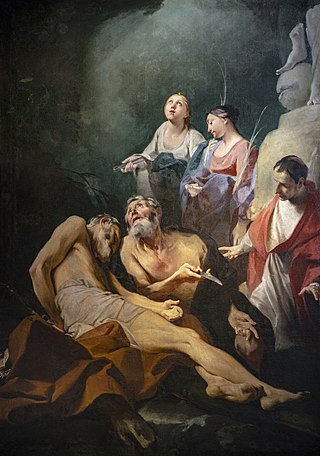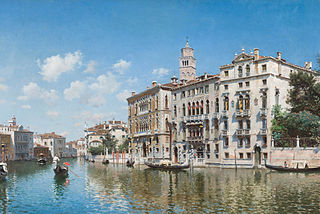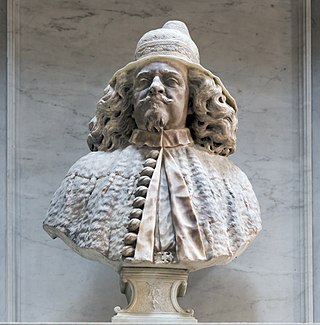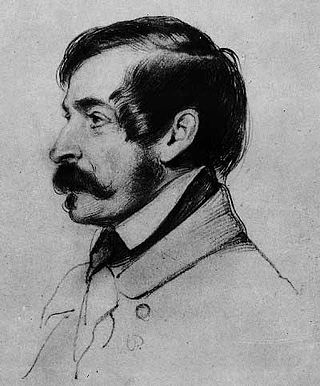Related Research Articles

The Basilica di Santa Maria Gloriosa dei Frari, commonly abbreviated to the Frari, is a church located in the Campo dei Frari at the heart of the San Polo district of Venice, Italy. It is the largest church in the city and it has the status of a minor basilica. The church is dedicated to the Assumption of Mary.

Ca' Rezzonico is a palazzo and art museum on the Grand Canal in the Dorsoduro sestiere of Venice, Italy. It is a particularly notable example of the 18th century Venetian baroque and rococo architecture and interior decoration, and displays paintings by the leading Venetian painters of the period, including Francesco Guardi and Giambattista Tiepolo. It is a public museum dedicated to 18th-century Venice and one of the 11 venues managed by the Fondazione Musei Civici di Venezia.

The Gallerie dell'Accademia is a museum gallery of pre-19th-century art in Venice, northern Italy. It is housed in the Scuola della Carità on the south bank of the Grand Canal, within the sestiere of Dorsoduro. It was originally the gallery of the Accademia di Belle Arti di Venezia, the art academy of Venice, from which it became independent in 1879, and for which the Ponte dell'Accademia and the Accademia boat landing station for the vaporetto water bus are named. The two institutions remained in the same building until 2004, when the art school moved to the Ospedale degli Incurabili.

Ventura di Archangelo Salimbeni was an Italian Counter-Maniera painter and printmaker highly influenced by the vaghezza and sensual reform of Federico Barocci.

Sebastiano Ricci was an Italian painter of the late Baroque school of Venice. About the same age as Piazzetta, and an elder contemporary of Tiepolo, he represents a late version of the vigorous and luminous Cortonesque style of grand manner fresco painting.

Federico Bencovich was a late Baroque painter from Dalmatia working in Italy. He is best known as Federico Bencovich or Federigo or Federighetto or Dalmatino. In modern Croatia he is known as Federiko Benković.

Francesco Trevisani was an Italian painter, active in the period called either early Rococo or late Baroque (barochetto).

Pietro Faccini or Facini (1562–1602), was an Italian painter, draughtsman and printmaker. He was active near his birthplace of Bologna working in a style bridging Mannerism and the nascent Baroque.

Giuseppe Angeli was an Italian painter of the late-Baroque, known for depicting both genre and religious subjects.

Ettore Tito was an Italian artist particularly known for his paintings of contemporary life and landscapes in Venice and the surrounding region. He trained at the Accademia di Belle Arti in Venice and from 1894 to 1927 was the Professor of Painting there. Tito exhibited widely and was awarded the Grand Prize in painting at the 1915 Panama–Pacific International Exposition in San Francisco. In 1926 he was made a member of the Royal Academy of Italy. Tito was born in Castellammare di Stabia in the province of Naples and died in Venice, the city which was his home for most of his life.

Emilio De Fabris was an Italian architect best known for his design of the west facade of Santa Maria del Fiore, Florence.

Cosroe Dusi was an Italian painter in the Neoclassical style, active for many years in St Petersburg, Russia, painting mainly sacred and historical subjects. Dusi was nicknamed by his contemporaries the "modern Tintoretto", for his liveliness of invention and rapidity at painting.

Federico del Campo (1837-1923) was a Peruvian painter who was active in Venice where he was one of the leading vedute painters of the 19th century. Demand for his views, particularly from English tourists was so strong that he painted several views multiple times.

Antonio Gai was an Italian sculptor, active in his native Venice and Veneto during the late-Baroque period.
Antonio Simonazzi was an Italian painter, active mainly in his native Modena.

The Barbarigo Altarpiece or Enthroned Madonna and Child with Angel Musicians and Saint Mark, Saint Augustine and Doge Agostino Barbarigo is a 1488 oil painting on panel by Giovanni Bellini, now in the church of San Pietro Martire in Murano.
Giuseppe Segusini was an Italian neoclassical architect.

Giovanni Maria Mosca or Giovanni Padovano was an Italian Renaissance sculptor and medallist, active between 1515 and 1573, initially in the Veneto and after 1529 in Poland, where his first name was rendered Jan.

Federico Cornaro or Corner was a 14th-century Venetian patrician, merchant and politician. In 1379, he was accounted the richest man in Venice, having become wealthy from his sugar plantations in Cyprus. He used this wealth to buy his son a marriage with the heiress of the Lordship of Argos and Nauplia in Greece, which he de facto ruled in their name until his death.

Marco Casagrande was an Italian sculptor, active in Veneto and Hungary. His name is often overlooked because his works, in neoclassical style, all of excellent workmanship, are often mistakenly attributed by most to Zandomeneghi, his teacher, or to his most illustrious fellow countryman, Canova.
References
- ↑ Web Gallery of Art, entry.
- ↑ Elogio di Alessandro Leopardi, read 8 August 1858 At the Royal Academy of Fine Arts in Venice, by cav. Pietro Zandomeneghi.
- ↑ Otto giorni a Venezia, 8th edition, by Antonio Quadri, page 336.
- ↑ Edizione Polistampa, entry on monograph on Federico.